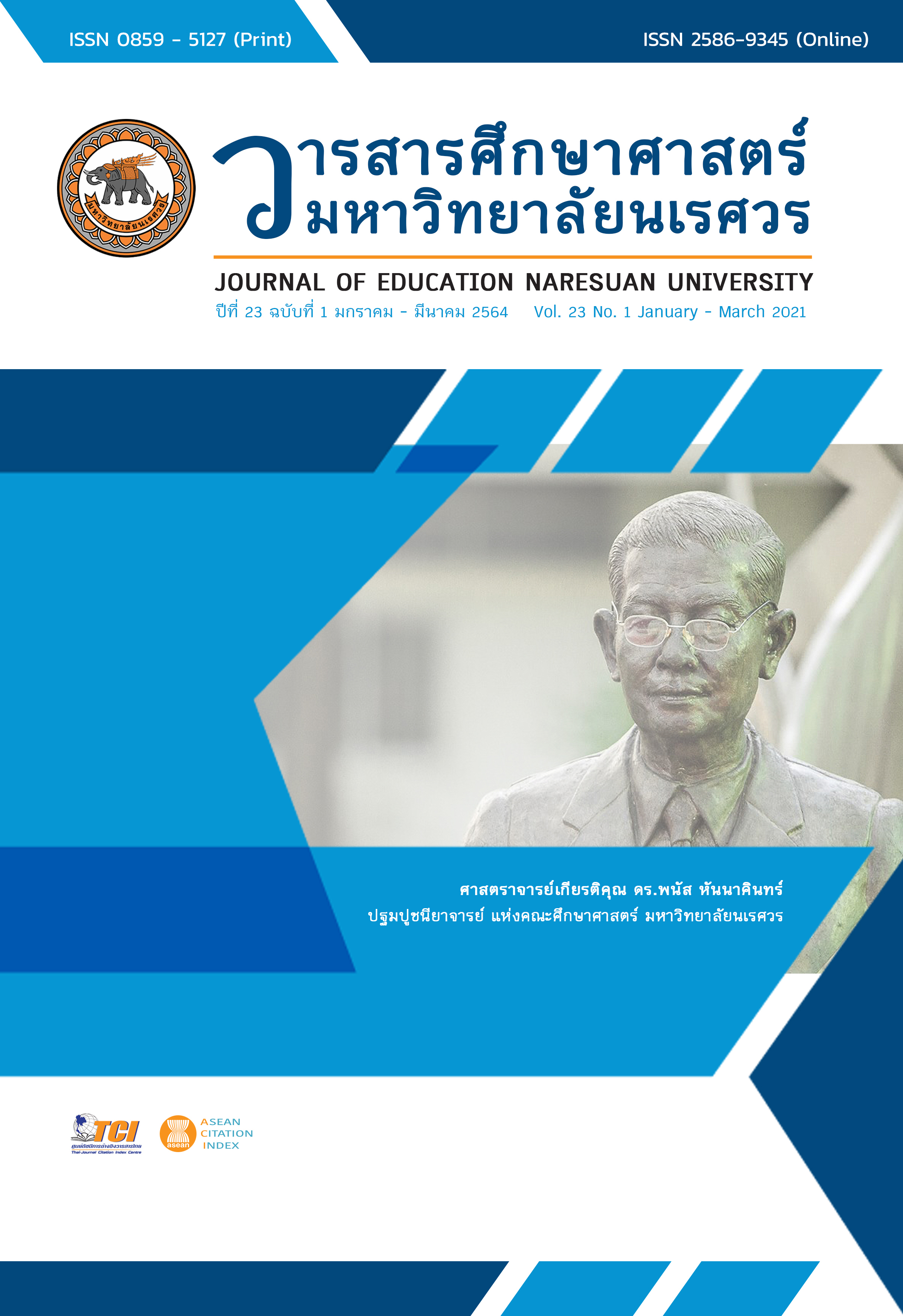ผลการจัดการเรียนรู้ตามแนวทางสะเต็มศึกษาเรื่อง อัตราส่วน สัดส่วน และร้อยละ ที่ส่งเสริมความสามารถในการคิดเชิงคำนวณของนักเรียนชั้นมัธยมศึกษาปีที่ 1 THE EFFECTS OF LEARNING ACTIVITIES ON RATIO, PROPORTION AND PERCENTAGE BASED UPON STEM EDUCATION ON GRADE 7 STUDENTS’ COMPUTATIONAL THINKING ABILITY
Main Article Content
บทคัดย่อ
การวิจัยครั้งนี้มีวัตถุประสงค์เพื่อศึกษาผลการจัดการเรียนรู้ตามแนวทางสะเต็มศึกษา เรื่อง อัตราส่วน สัดส่วน และร้อยละ ที่ส่งเสริมความสามารถในการคิดเชิงคำนวณ ของนักเรียนชั้นมัธยมศึกษาปีที่ 1 โดยกลุ่มเป้าหมายคือ นักเรียนชั้นมัธยมศึกษาปีที่ 1 จำนวน 28 คน ของโรงเรียนมัธยมศึกษาขนาดเล็กแห่งหนึ่งในจังหวัดพิษณุโลก งานวิจัยนี้ใช้รูปแบบการวิจัยเชิงปฏิบัติการในชั้นเรียน เครื่องมือที่ใช้ในการวิจัย ได้แก่ แผนการจัดการเรียนรู้ จำนวน 3 แผน ใบกิจกรรม และแบบวัดความสามารถในการคิดเชิงคำนวณ แล้ววิเคราะห์ข้อมูลโดยใช้การวิเคราะห์แบบแยกประเด็น ผลการวิจัย พบว่า นักเรียนส่วนใหญ่มีระดับความสามารถในการคิดเชิงคำนวณอยู่ในระดับยอดเยี่ยมหลังจากการจัดการเรียนรู้ตามแนวทางสะเต็มศึกษา เมื่อพิจารณาความสามารถในองค์ประกอบย่อยของการคิดเชิงคำนวณ พบว่า นักเรียนส่วนใหญ่มีความสามารถในการแบ่งปัญหาใหญ่ออกเป็นปัญหาย่อย การพิจารณารูปแบบของปัญหาหรือวิธีการแก้ปัญหา และการพิจารณาสาระสำคัญของปัญหาอยู่ในระดับยอดเยี่ยม สำหรับความสามารถในการออกแบบอัลกอริทึมของนักเรียนส่วนใหญ่อยู่ในระดับดี
Article Details
เจ้าของบทความมิได้คัดลอก หรือละเมิดลิขสิทธิ์ของผู้ใด หากเกิดการละเมิดลิขสิทธิ์ ไม่ว่าวิธีใด หรือการฟ้องร้องไม่ว่ากรณีใด ๆ ที่อาจเกิดขึ้นได้ กองบรรณาธิการวารสารศึกษาศาสตร์ ไม่มีส่วนเกี่ยวข้องทั้งสิ้น ให้เป็นสิทธิ์ของเจ้าของบทความที่จะดำเนินการ
References
Barcelos, T. S., Munoz, R., Villarroel, R., Merino, E., & Silveira, I. F. (2018). Mathematics learning through computational thinking activities: A systematic literature review. Journal of Universal Computer Science, 24(7), 815.
Cox, C., Birdy, R., Christian, S., & Anita, S. (2016). Using mathematics and engineering to solve problems in secondary level biology. Journal of STEM Education, 17(1), 22-30.
English, L. D., & King, D. T. (2015). STEM learning through engineering design: Fourth grade students’ investigations in aerospace. International journal of STEM education, 2(14), 1-18.
Kemmis, S., & McTaggart, R. (2000). The SAGE handbook of qualitative research. Thousand Oaks, CA: Sage.
Ministry of Education. (2017). Indicators and core curriculum for science learning (revised B.E. 2560) Basic education core curriculum BE 2551. Bangkok: The Agricultural Co-operative Federation of Thailand. [in Thai]
Palts, T., & Pedaste, M. (2020). A model for developing computational thinking skills. Informatics in Education, 19(1), 113–128.
Roungrong, P., Kaewurai, R., Namoungon, S., Changkwanyeun, A., & Tengkew, S. (2018). Computational thinking with Thai education. Panyapiwat Journal, 10(3), 322 – 330. [in Thai]
Sabkerd, S. (2016). Development of learning activities to enhance computational thinking with focus on STEM education learning management of the programming & application course for mathayomsuksa IV students of Anukoolnaree School (Master thesis). Maha Sarakham: Rajabhat Mahasarakham University. [in Thai]
Srithi, K., Supap, W., & Viriyapong, R. (2018). An action research on developing problem-based learning activities to enhance mathematical literacy in conic sections topic of students in grade 10. Social Sciences Research and Academic Journals, 13(37), 105-118. [in Thai]
Swaid, S. I. (2015). Bringing computational thinking to STEM education. Science Direct, 3, 3657-3662.
The Institute for the Promotion of Teaching Science and Technology (IPST). (2014). STEM Education. Bangkok: The Institute for the Promotion of Teaching Science and Technology. [in Thai]
The Institute for the Promotion of Teaching Science and Technology (IPST). (2017). Manual for teacher in science foundation course technology (computer science). Bangkok: The Institute for the Promotion of Teaching Science and Technology. [in Thai]
The Institute for the Promotion of Teaching Science and Technology (IPST). (2020). FOCUS in PISA. Retrieved June 11, 2020, from https://pisathailand.ipst.ac.th/issue-2020-53/ [in Thai]
Tibpaeng, R., Klineam, C., & Supap, W. (2019). The development of mathematical connection ability through context-based learning in ratio and percentage for tribesman students in grade 8. In The 48nd National Graduate Research Conference. Nakhon Pathom: Silpakorn University. [in Thai]
Tidma, P., Nakkuntod, M., & Kijkuakul, S. (2015). STEM education in topic of human systems to promote creative thinking of grade 8 students. Ratchaphruek Journal, 13(3), 71-76. [in Thai]
Wing, J. M. (2006). Computational thinking. Communication of the ACM, 49(3), 33-35.

